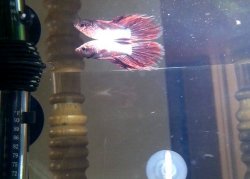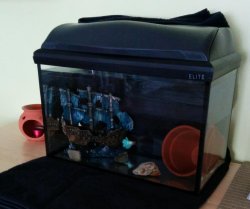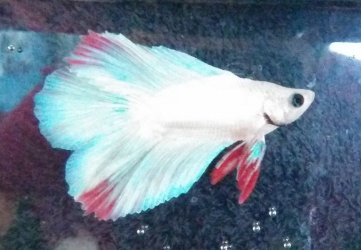Meeresstille
Fish Addict
This is just too weird, and I hope someone can help us find an answer.
Betta fish # 1
We've set up a 5 gallon tank, used cycled media from the big tank to get a head start on the cycling, Aqua Plus used for dechlorinator. Got a Betta from a LFS with a good reputation.
Within hours the fish slowed down, started hiding, we chalked it off to the fish feeling stressed having moved from a little cup to a 5 gallon tank...
on day 2 or 3 the fish had an intestinal prolapse and was brought back to the store. Speculation was that he had parasites, another Betta was given in exchange.
Betta fish # 2
Tank was cleaned, media thrown out, new cycled media put in, a nerite snail was added, and some plants for the Betta to hide in. Switched from Aqua Plus to Prime to dechlorinate. Everything was fine for one whole day. Then this Betta too started hiding, developed cloudy eye and next morning he was dead in the tank. Dead fish was brought back to the store, the possibility of bad shipment was discussed, another Betta was given in exchange.
Betta fish # 3
Tank was cleaned with salt and with vinegar, everything was boiled, (even boiling water poured into the tank (yikes, thank goodness the seals held and the glass did not break) media thrown out, again more cycled media pinched off the main tank, the plants were put in a bucket, new plants added to the tank. Again it started with fish hiding, clamped fins, this one developed dropsy, Nerite snail removed, Epsom Salt was added, API General Cure was bought and used in case the problem were parasites, API Triple Sulfa was bought and used in case it was a Bacterial infection. The Betta first started showing signs of getting better, but one day he just could not fight anymore. The sypmtoms of dropsy got worse and Betta was euthanized.
Betta fish # 4
A brand new tank was bought, a kit that included the filter and a heater, nothing from the previous tank was being used, bare bottom tank, not even cycled media was added. Another Betta was bought, and within hours of adding him his eyes also started getting cloudy, slime coat was sloughing off (one of the other Bettas too had this happen, not sure which one). There is no way anything had cross-contaminated this tank, and on a hunch decided to add 1 tsp of salt per gallon. Knowing that nothing on the decor or the plants could have been the cause of any of it, the tank was made more comfortable for the Betta, by adding the wood and some plants (they are showing some signs of damage from the medicated water they were sitting in, but oh well, they were rinsed off before adding them to the tank! Over night the Betta has already started to look better. His eyes are clearing again. He is acting OK, but there still are some remnants of slime coat hanging off.
What is going on? Why is this happening? Is there something wrong with the Bettas? I just can't see where we went wrong? They were acclimated slowly by floating the bag in the water, water being removed from the bag, and tank water being added, over a period of an hour. Are there medications in the little cups to keep the Bettas looking well, but once they are going into unmedicated water they get ill?
Tap water shows no signs of Ammonia, but once treated with Prime it shows Ammonia of .6! Good news is that the pH is sitting at 6, so there is very, very little of actual harmful ammonia in the water. Water changes were done whenever any of the fish showed signs of something being wrong.
Used filter media has since been added to the filter to help eat up the Ammonia/Ammonium, as well as some crushed coral which has brought the pH up to 6.5. The pH at the LFS is at 7. Nitrates are already showing at 5 in the tank.
Only one of the Bettas ever accepted any food. New Life Spectrum Betta pellets and frozen blood worms, but not much. Uneaten foods were removed from tank!
Sorry for the long post, I really hope someone can help us.
This is Betta # 4

Betta fish # 1
We've set up a 5 gallon tank, used cycled media from the big tank to get a head start on the cycling, Aqua Plus used for dechlorinator. Got a Betta from a LFS with a good reputation.
Within hours the fish slowed down, started hiding, we chalked it off to the fish feeling stressed having moved from a little cup to a 5 gallon tank...
on day 2 or 3 the fish had an intestinal prolapse and was brought back to the store. Speculation was that he had parasites, another Betta was given in exchange.
Betta fish # 2
Tank was cleaned, media thrown out, new cycled media put in, a nerite snail was added, and some plants for the Betta to hide in. Switched from Aqua Plus to Prime to dechlorinate. Everything was fine for one whole day. Then this Betta too started hiding, developed cloudy eye and next morning he was dead in the tank. Dead fish was brought back to the store, the possibility of bad shipment was discussed, another Betta was given in exchange.
Betta fish # 3
Tank was cleaned with salt and with vinegar, everything was boiled, (even boiling water poured into the tank (yikes, thank goodness the seals held and the glass did not break) media thrown out, again more cycled media pinched off the main tank, the plants were put in a bucket, new plants added to the tank. Again it started with fish hiding, clamped fins, this one developed dropsy, Nerite snail removed, Epsom Salt was added, API General Cure was bought and used in case the problem were parasites, API Triple Sulfa was bought and used in case it was a Bacterial infection. The Betta first started showing signs of getting better, but one day he just could not fight anymore. The sypmtoms of dropsy got worse and Betta was euthanized.
Betta fish # 4
A brand new tank was bought, a kit that included the filter and a heater, nothing from the previous tank was being used, bare bottom tank, not even cycled media was added. Another Betta was bought, and within hours of adding him his eyes also started getting cloudy, slime coat was sloughing off (one of the other Bettas too had this happen, not sure which one). There is no way anything had cross-contaminated this tank, and on a hunch decided to add 1 tsp of salt per gallon. Knowing that nothing on the decor or the plants could have been the cause of any of it, the tank was made more comfortable for the Betta, by adding the wood and some plants (they are showing some signs of damage from the medicated water they were sitting in, but oh well, they were rinsed off before adding them to the tank! Over night the Betta has already started to look better. His eyes are clearing again. He is acting OK, but there still are some remnants of slime coat hanging off.
What is going on? Why is this happening? Is there something wrong with the Bettas? I just can't see where we went wrong? They were acclimated slowly by floating the bag in the water, water being removed from the bag, and tank water being added, over a period of an hour. Are there medications in the little cups to keep the Bettas looking well, but once they are going into unmedicated water they get ill?
Tap water shows no signs of Ammonia, but once treated with Prime it shows Ammonia of .6! Good news is that the pH is sitting at 6, so there is very, very little of actual harmful ammonia in the water. Water changes were done whenever any of the fish showed signs of something being wrong.
Used filter media has since been added to the filter to help eat up the Ammonia/Ammonium, as well as some crushed coral which has brought the pH up to 6.5. The pH at the LFS is at 7. Nitrates are already showing at 5 in the tank.
Only one of the Bettas ever accepted any food. New Life Spectrum Betta pellets and frozen blood worms, but not much. Uneaten foods were removed from tank!
Sorry for the long post, I really hope someone can help us.
This is Betta # 4


 /www.waterlife.co.uk/waterlife/bacterlife.htm
/www.waterlife.co.uk/waterlife/bacterlife.htm
